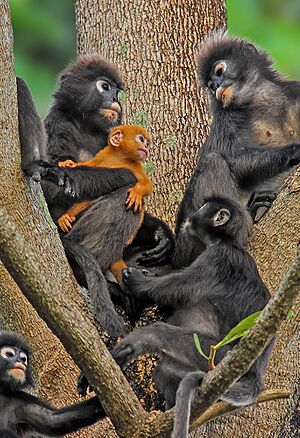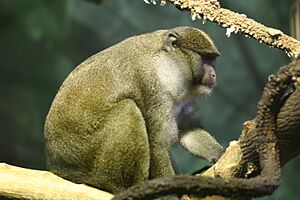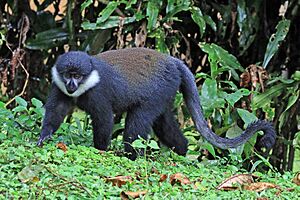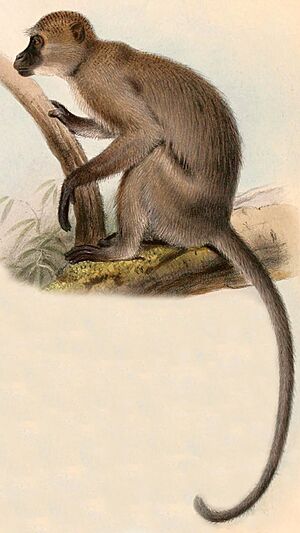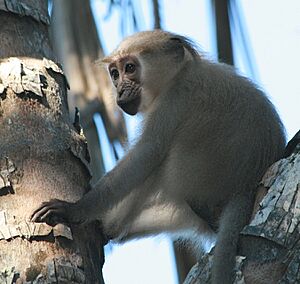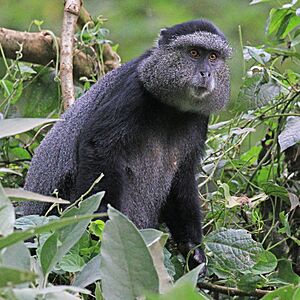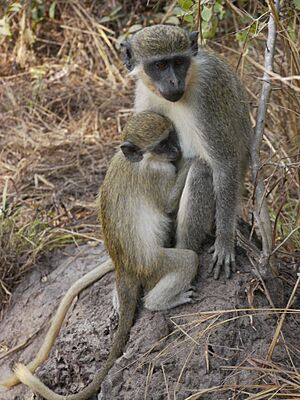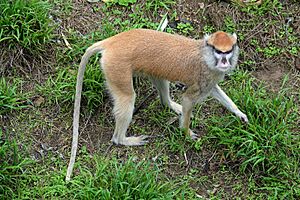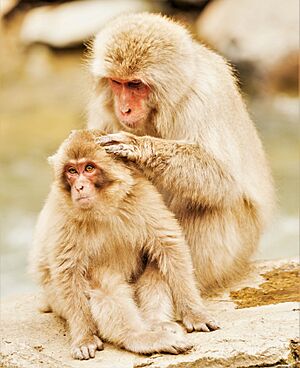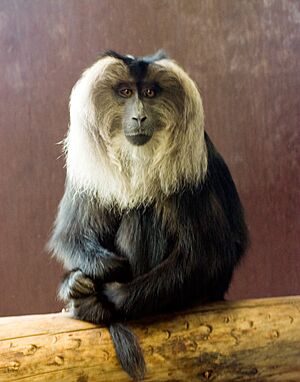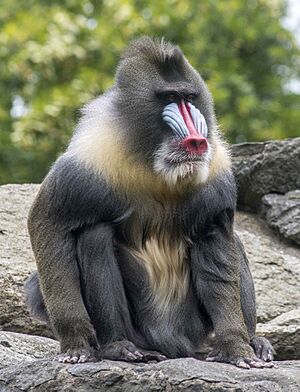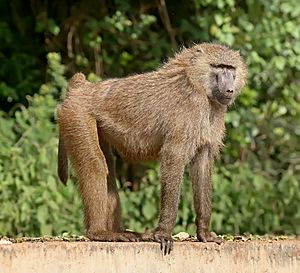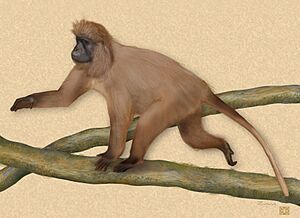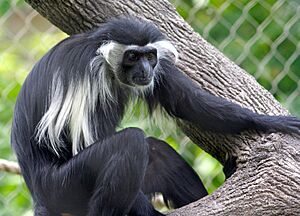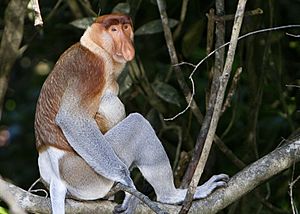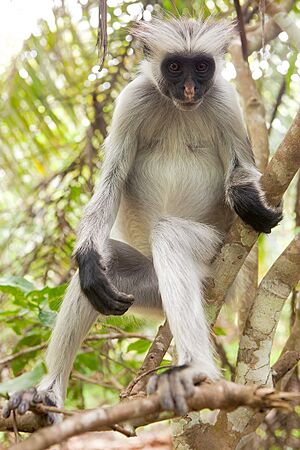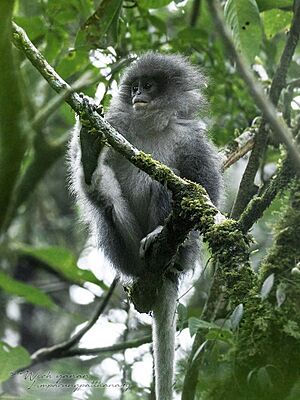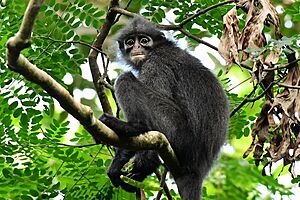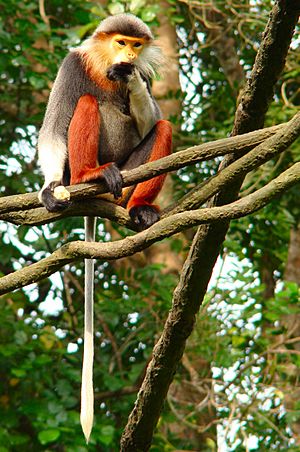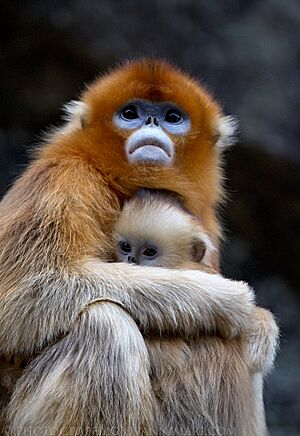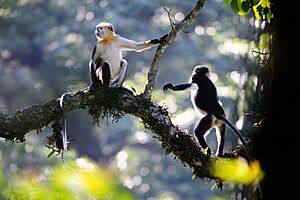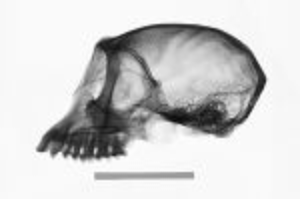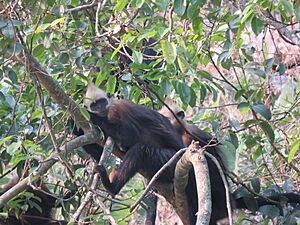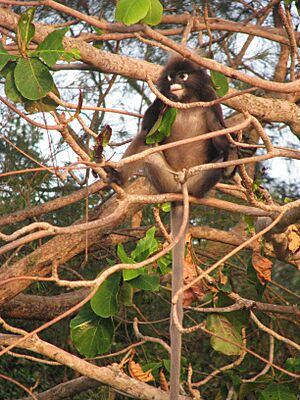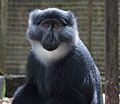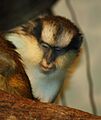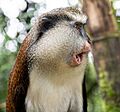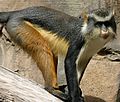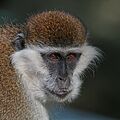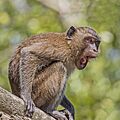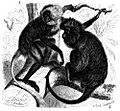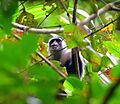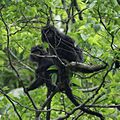List of cercopithecoids facts for kids
Old World monkeys, also known as cercopithecoids, are a large group of primates. This group includes many monkeys you might know, like baboons, colobuses, guenons, lutungs, and macaques. They are found in different parts of Asia and Africa, living mostly in forests, but some also live in shrublands, wetlands, and even caves!
Old World monkeys come in many sizes. The smallest is the Gabon talapoin, which is about 23 cm (9 in) long, plus its tail. The largest is the kipunji, which can be up to 90 cm (35 in) long, with a tail that's even longer! These monkeys mainly eat leaves, fruit, and seeds.
Sadly, many Old World monkey species are in danger. Forty-eight species are considered endangered, and twenty-six species are even more at risk, listed as critically endangered.
There are 158 types of Old World monkeys alive today. They are split into two main groups:
- Cercopithecinae: This group has 78 species, including baboons, guenons, and macaques.
- Colobinae: This group has 80 species, including colobuses and lutungs.
Scientists are always learning more about these monkeys, and sometimes they discover new things or change how they classify them.
Contents
Meet the Old World Monkeys
This section introduces some of the different kinds of Old World monkeys. Their conservation status is based on the International Union for Conservation of Nature (IUCN) Red List.
Monkeys of the Cercopithecinae Group
This group includes many well-known monkeys like baboons and macaques.
Allen's Swamp Monkey
- Name: Allen's swamp monkey (Allenopithecus nigroviridis)
- Where they live: Central Africa.
- Size: About 33–51 cm (13–20 in) long, with a tail of 35–52 cm (14–20 in).
- Habitat: Forests.
- What they eat: Fruit, leaves, and small insects.
- Status: Least Concern (LC) – their population is decreasing.
L'Hoest's Monkey
- Name: L'Hoest's monkey (Allochrocebus lhoesti)
- Where they live: Central Africa.
- Size: About 31–69 cm (12–27 in) long, with a tail of 48–10 cm (19–4 in).
- Habitat: Forests.
- What they eat: Fruit, leaves, mushrooms, and insects.
- Status: Vulnerable (VU) – their population is decreasing.
Agile Mangabey
- Name: Agile mangabey (Cercocebus agilis)
- Where they live: Central Africa.
- Size: About 44–65 cm (17–26 in) long, with a tail of 45–79 cm (18–31 in).
- Habitat: Forests.
- What they eat: Fruit, seeds, shoots, and small vertebrates.
- Status: Least Concern (LC) – their population is decreasing.
Tana River Mangabey
- Name: Tana River mangabey (Cercocebus galeritus)
- Where they live: Eastern Africa.
- Size: About 44–63 cm (17–25 in) long, with a tail of 50–68 cm (20–27 in).
- Habitat: Forests, shrublands, and wetlands.
- What they eat: Fruit, seeds, stems, leaves, insects, and fungi.
- Status: Critically Endangered (CR) – only 100–1,000 individuals left, and their population is decreasing.
Blue Monkey
- Name: Blue monkey (Cercopithecus mitis)
- Where they live: Sub-Saharan Africa.
- Size: About 31–70 cm (12–28 in) long, with a tail of 55–109 cm (22–43 in).
- Habitat: Forests.
- What they eat: Fruit, leaves, and insects.
- Status: Least Concern (LC) – their population is decreasing.
Diana Monkey
- Name: Diana monkey (Cercopithecus diana)
- Where they live: Western Africa.
- Size: About 40–55 cm (16–22 in) long, with a tail of 50–75 cm (20–30 in).
- Habitat: Forests.
- What they eat: Fruit, flowers, leaves, and insects.
- Status: Endangered (EN) – their population is decreasing.
Green Monkey
- Name: Green monkey (Chlorocebus sabaeus)
- Where they live: Western Africa.
- Size: About 42–46 cm (17–18 in) long, with a tail of 42–72 cm (17–28 in).
- Habitat: Forests and savannas.
- What they eat: Fruit and leaves.
- Status: Least Concern (LC) – their population is decreasing.
Common Patas Monkey
- Name: Common patas monkey (Erythrocebus patas)
- Where they live: Equatorial Africa.
- Size: About 50–70 cm (20–28 in) long, with a tail of 50–70 cm (20–28 in).
- Habitat: Forests, savannas, shrublands, and grasslands.
- What they eat: Fruit, insects, leaves, roots, and bird eggs.
- Status: Near Threatened (NT) – their population is decreasing.
Japanese Macaque
- Name: Japanese macaque (Macaca fuscata)
- Where they live: Japan.
- Size: About 36–77 cm (14–30 in) long, with a tail of 1–15 cm (0.4–6 in).
- Habitat: Forests.
- What they eat: Fruit, seeds, flowers, nectar, leaves, and fungi.
- Status: Least Concern (LC) – their population is stable.
Lion-tailed Macaque
- Name: Lion-tailed macaque (Macaca silenus)
- Where they live: Southwestern India.
- Size: About 40–61 cm (16–24 in) long, with a tail of 24–38 cm (9–15 in).
- Habitat: Forests.
- What they eat: Fruit, leaves, stems, flowers, buds, fungi, insects, lizards, tree frogs, and small mammals.
- Status: Endangered (EN) – only 2,400–2,500 individuals left, and their population is decreasing.
Mandrill
- Name: Mandrill (Mandrillus sphinx)
- Where they live: Western Africa.
- Size: About 55–95 cm (22–37 in) long, with a tail of 7–10 cm (3–4 in).
- Habitat: Forests.
- What they eat: Fruit, seeds, fungi, roots, insects, snails, worms, frogs, lizards, snakes, and small vertebrates.
- Status: Vulnerable (VU) – their population is decreasing.
Olive Baboon
- Name: Olive baboon (Papio anubis)
- Where they live: Equatorial Africa.
- Size: About 61–84 cm (24–33 in) long, with a tail of 31–60 cm (12–24 in).
- Habitat: Forests, savannas, shrublands, and grasslands.
- What they eat: Fruit, gums, insects, eggs, seeds, flowers, grass, roots, and small vertebrates.
- Status: Least Concern (LC) – their population is stable.
Kipunji
- Name: Kipunji (Rungwecebus kipunji)
- Where they live: Southeastern Africa.
- Size: About 85–90 cm (33–35 in) long, with a tail of about 115 cm (45 in).
- Habitat: Forests.
- What they eat: They eat many things, including bulbs, roots, shoots, seeds, and fruit.
- Status: Endangered (EN) – their population is decreasing.
Monkeys of the Colobinae Group
This group includes leaf-eating monkeys like colobuses and langurs.
Angola Colobus
- Name: Angola colobus (Colobus angolensis)
- Where they live: Central Africa.
- Size: About 49–68 cm (19–27 in) long, with a tail of 70–83 cm (28–33 in).
- Habitat: Forests.
- What they eat: Leaves, stems, bark, flowers, buds, shoots, fruits, and insects.
- Status: Vulnerable (VU) – their population is decreasing.
Proboscis Monkey
- Name: Proboscis monkey (Nasalis larvatus)
- Where they live: Borneo.
- Size: About 61–76 cm (24–30 in) long, with a tail of 50–75 cm (20–30 in).
- Habitat: Forests.
- What they eat: Fruit, seeds, leaves, shoots, caterpillars, and larvae.
- Status: Endangered (EN) – their population is decreasing.
Zanzibar Red Colobus
- Name: Zanzibar red colobus (Piliocolobus kirkii)
- Where they live: Eastern Africa.
- Size: About 41–70 cm (16–28 in) long, with a tail of 42–80 cm (17–31 in).
- Habitat: Forests and shrublands.
- What they eat: Leaves, fruit, seeds, and flowers.
- Status: Endangered (EN) – about 5,900 individuals left, and their population is decreasing.
Javan Surili
- Name: Javan surili (Presbytis comata)
- Where they live: Island of Java in Indonesia.
- Size: About 42–61 cm (17–24 in) long, with a tail of 50–85 cm (20–33 in).
- Habitat: Forests.
- What they eat: Leaves, fruits, flowers, and seeds.
- Status: Vulnerable (VU) – about 5,500 individuals left, and their population is decreasing.
Raffles' Banded Langur
- Name: Raffles' banded langur (Presbytis femoralis)
- Where they live: Singapore and southern Peninsular Malaysia.
- Size: About 42–61 cm (17–24 in) long, with a tail of 50–85 cm (20–33 in).
- Habitat: Forests.
- What they eat: Fruit, seeds, and leaves.
- Status: Critically Endangered (CR) – only 200–250 individuals left, and their population is decreasing.
Olive Colobus
- Name: Olive colobus (Procolobus verus)
- Where they live: Western Africa.
- Size: About 43–50 cm (17–20 in) long, with a tail of 57–64 cm (22–25 in).
- Habitat: Forests.
- What they eat: Leaves and flowers.
- Status: Vulnerable (VU) – their population is decreasing.
Red-shanked Douc
- Name: Red-shanked douc (Pygathrix nemaeus)
- Where they live: Southeastern Asia.
- Size: About 61–77 cm (24–30 in) long, with a tail of 55–77 cm (22–30 in).
- Habitat: Forests.
- What they eat: Leaves, unripe fruit, seeds, and flowers.
- Status: Critically Endangered (CR) – their population is decreasing.
Golden Snub-nosed Monkey
- Name: Golden snub-nosed monkey (Rhinopithecus roxellana)
- Where they live: Central China.
- Size: About 57–76 cm (22–30 in) long, with a tail of 51–72 cm (20–28 in).
- Habitat: Forests.
- What they eat: Leaves, bark, lichen, buds, and fruit seeds.
- Status: Endangered (EN) – their population is decreasing.
Tonkin Snub-nosed Monkey
- Name: Tonkin snub-nosed monkey (Rhinopithecus avunculus)
- Where they live: Northern Vietnam.
- Size: About 51–65 cm (20–26 in) long, with a tail of 66–92 cm (26–36 in).
- Habitat: Forests.
- What they eat: Leaves, fruit, flowers, and seeds.
- Status: Critically Endangered (CR) – only 80–100 individuals left, and their population is decreasing.
Nilgiri Langur
- Name: Nilgiri langur (Semnopithecus johnii)
- Where they live: Southern India.
- Size: About 41–78 cm (16–31 in) long, with a tail of 69–108 cm (27–43 in).
- Habitat: Forests.
- What they eat: Leaves, fruit, and flowers.
- Status: Vulnerable (VU) – about 9,500–10,000 individuals left, and their population is stable.
Pig-tailed Langur
- Name: Pig-tailed langur (Simias concolor)
- Where they live: Islands near Sumatra in Indonesia.
- Size: About 45–53 cm (18–21 in) long, with a tail of 13–18 cm (5–7 in).
- Habitat: Forests.
- What they eat: Leaves, fruit, and berries.
- Status: Critically Endangered (CR) – their population is decreasing.
Cat Ba Langur
- Name: Cat Ba langur (Trachypithecus poliocephalus)
- Where they live: Cát Bà Island, Vietnam.
- Size: About 40–76 cm (16–30 in) long, with a tail of 57–110 cm (22–43 in).
- Habitat: Forests and caves.
- What they eat: Leaves, flowers, and fruit.
- Status: Critically Endangered (CR) – only 30–35 individuals left, but their population is increasing!
Dusky Leaf Monkey
- Name: Dusky leaf monkey (Trachypithecus obscurus)
- Where they live: Southeastern Asia.
- Size: About 42–61 cm (17–24 in) long, with a tail of 50–85 cm (20–33 in).
- Habitat: Forests.
- What they eat: Leaves, shoots, fruit, and seedlings.
- Status: Endangered (EN) – their population is decreasing.
François' Langur
- Name: François' langur (Trachypithecus francoisi)
- Where they live: Southern Asia.
- Size: About 40–76 cm (16–30 in) long, with a tail of 57–110 cm (22–43 in).
- Habitat: Forests, rocky areas, and caves.
- What they eat: Leaves, fruit, seeds, and insects.
- Status: Endangered (EN) – about 2,000–2,100 individuals left, and their population is decreasing.
Popa Langur
- Name: Popa langur (Trachypithecus popa)
- Where they live: Myanmar.
- Size: About 40–76 cm (16–30 in) long, with a tail of 57–110 cm (22–43 in).
- Habitat: Forests.
- What they eat: Leaves, flowers, and fruit.
- Status: Critically Endangered (CR) – only 130–180 individuals left, and their population is decreasing.
Images for kids


